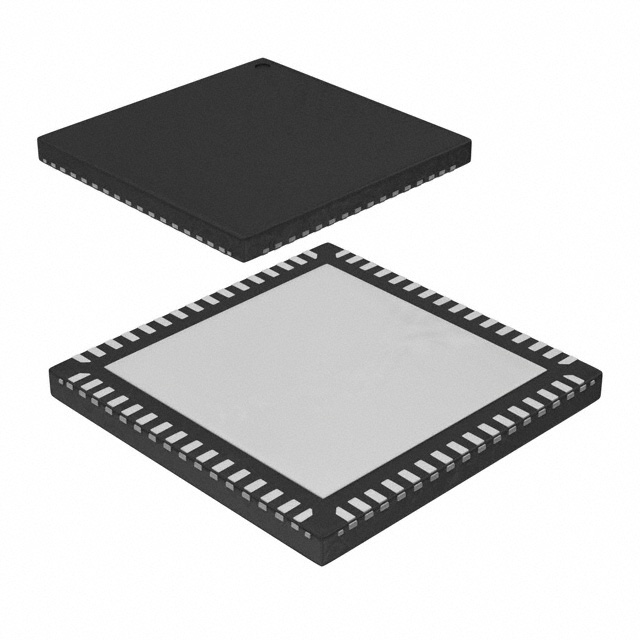ATMEGA128A-MU
Product Overview
Category
ATMEGA128A-MU belongs to the category of microcontrollers.
Use
It is commonly used in various electronic applications that require a microcontroller for processing and controlling tasks.
Characteristics
- High-performance microcontroller with advanced features
- Low power consumption
- Wide operating voltage range
- Large program memory capacity
- Multiple communication interfaces
- Rich set of peripherals
Package
ATMEGA128A-MU is available in a compact and durable package, suitable for surface mount technology (SMT) applications.
Essence
The essence of ATMEGA128A-MU lies in its ability to provide efficient and reliable control and processing capabilities in electronic systems.
Packaging/Quantity
ATMEGA128A-MU is typically packaged in reels or trays, with a quantity of 250 units per reel/tray.
Specifications
- Microcontroller architecture: AVR
- CPU frequency: Up to 16 MHz
- Flash memory: 128 KB
- RAM: 4 KB
- EEPROM: 4 KB
- Operating voltage: 2.7V to 5.5V
- Digital I/O pins: 86
- Analog input channels: 8
- Communication interfaces: UART, SPI, I2C
- Timers/counters: 4
- PWM channels: 6
- ADC resolution: 10-bit
- Operating temperature range: -40°C to +85°C
Detailed Pin Configuration
The ATMEGA128A-MU microcontroller has a total of 100 pins. The pin configuration is as follows:
- Pins 1-8: Port A (PA0-PA7)
- Pins 9-16: Port B (PB0-PB7)
- Pins 17-24: Port C (PC0-PC7)
- Pins 25-32: Port D (PD0-PD7)
- Pins 33-40: Port E (PE0-PE7)
- Pins 41-48: Port F (PF0-PF7)
- Pins 49-56: Port G (PG0-PG7)
- Pins 57-64: Port H (PH0-PH7)
- Pins 65-72: Port J (PJ0-PJ7)
- Pins 73-80: Port K (PK0-PK7)
- Pins 81-88: Port L (PL0-PL7)
- Pins 89-96: VCC, GND, XTAL1, XTAL2, AVCC, AREF, AGND, and RESET
- Pins 97-100: ADC6, ADC7, ADC8, and ADC9
Functional Features
- High-performance RISC architecture for efficient execution of instructions
- Advanced on-chip peripherals for versatile applications
- Power-saving modes to optimize energy consumption
- Enhanced security features for data protection
- Flexible clocking options for precise timing requirements
- Extensive interrupt handling capabilities for real-time responsiveness
Advantages and Disadvantages
Advantages
- Powerful processing capabilities suitable for complex applications
- Low power consumption for extended battery life
- Wide operating voltage range allows compatibility with various power sources
- Abundance of I/O pins and communication interfaces for connectivity options
- Large program memory capacity enables the implementation of sophisticated algorithms
Disadvantages
- Relatively higher cost compared to simpler microcontrollers
- Steeper learning curve due to the complexity of advanced features
- Limited availability of alternative models with similar specifications
Working Principles
ATMEGA128A-MU operates based on the principles of digital logic and microcontroller architecture. It executes instructions stored in its program memory, interacts with peripherals and external devices through various communication interfaces, and responds to events and interrupts in real-time.
Detailed Application Field Plans
ATMEGA128A-MU finds applications in a wide range of fields, including but not limited to: - Industrial automation - Robotics - Home automation - Automotive electronics - Internet of Things (IoT) devices - Medical equipment - Consumer electronics
Alternative Models
While ATMEGA128A-MU is a highly capable microcontroller, there are alternative models available that offer similar functionality. Some notable alternatives include: - ATMEGA2560 - PIC18F4550 - STM32F407
These alternative models provide comparable features and can be considered based on specific project requirements.
In conclusion, ATMEGA128A-MU is a high-performance microcontroller with advanced features, suitable for a wide range of electronic applications. Its efficient processing capabilities, low power consumption, and versatile peripherals make it a popular choice among developers.
قم بإدراج 10 أسئلة وإجابات شائعة تتعلق بتطبيق ATMEGA128A-MU في الحلول التقنية
Sure! Here are 10 common questions and answers related to the application of ATMEGA128A-MU in technical solutions:
Q: What is ATMEGA128A-MU? A: ATMEGA128A-MU is a microcontroller unit (MCU) from the ATmega series, manufactured by Microchip Technology. It offers high-performance computing capabilities and is widely used in various technical solutions.
Q: What are the key features of ATMEGA128A-MU? A: Some key features of ATMEGA128A-MU include 128KB of flash memory, 4KB of EEPROM, 4KB of SRAM, 53 general-purpose I/O pins, multiple communication interfaces (UART, SPI, I2C), and a wide operating voltage range.
Q: What applications can ATMEGA128A-MU be used for? A: ATMEGA128A-MU can be used in a wide range of applications such as industrial automation, robotics, home automation, IoT devices, consumer electronics, and automotive systems.
Q: How do I program ATMEGA128A-MU? A: ATMEGA128A-MU can be programmed using various development tools and programming languages such as Atmel Studio, Arduino IDE, or MPLAB X IDE. You can use a programmer like AVRISP mkII or USBasp to flash the firmware onto the MCU.
Q: Can I use ATMEGA128A-MU with Arduino? A: Yes, ATMEGA128A-MU is compatible with the Arduino platform. You can use the Arduino IDE and libraries to develop and upload code to the MCU.
Q: What is the maximum clock frequency supported by ATMEGA128A-MU? A: ATMEGA128A-MU can operate at a maximum clock frequency of 16 MHz when powered by an external crystal oscillator.
Q: Does ATMEGA128A-MU have built-in analog-to-digital converters (ADC)? A: Yes, ATMEGA128A-MU has an 8-channel, 10-bit ADC module that allows you to convert analog signals into digital values for processing.
Q: Can I interface ATMEGA128A-MU with other microcontrollers or devices? A: Yes, ATMEGA128A-MU supports various communication interfaces like UART, SPI, and I2C, which allow you to easily interface with other microcontrollers, sensors, displays, and peripheral devices.
Q: Is ATMEGA128A-MU suitable for low-power applications? A: Yes, ATMEGA128A-MU offers several power-saving features such as sleep modes, power reduction registers, and brown-out detection, making it suitable for low-power applications.
Q: Where can I find documentation and resources for ATMEGA128A-MU? A: You can find the datasheet, application notes, and other resources for ATMEGA128A-MU on the Microchip Technology website. Additionally, online forums and communities dedicated to microcontrollers are great places to seek help and share knowledge.


